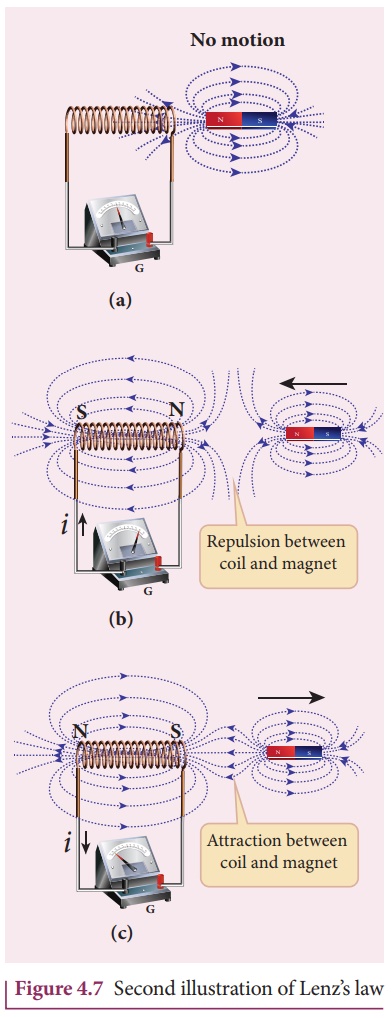Definition, Explanation | Electromagnetic Induction - LenzŌĆÖs law | 12th Physics : Electromagnetic Induction and Alternating Current
Chapter: 12th Physics : Electromagnetic Induction and Alternating Current
LenzŌĆÖs law
LenzŌĆÖs law
A German physicist
Heinrich Lenz performed his own experiments on electromagnetic induction and
deduced a law to determine the direction of the induced current. This law is
known as LenzŌĆÖs law.
LenzŌĆÖs law states that
the direction of the induced current is such that it always opposes the cause
responsible for its production.
Faraday discovered that
when magnetic flux linked with a coil changes, an electric current is induced
in the circuit. Here the flux change is the cause while the induction of
current is the effect. LenzŌĆÖs law says that the effect always opposes the
cause. Therefore, the induced current would flow in a direction so that it
could oppose the flux change.
To understand LenzŌĆÖs
law, let us consider two illustrations in which we find the direction of the
induced current in a circuit.
Illustration 1
Consider a uniform
magnetic field, with its field lines perpendicular to the plane of the paper
and pointing inwards. These field lines are represented by crosses (x) as shown
in Figure 4.6(a). A rectangular metallic frame ABCD is placed in this
magnetic field, with its plane perpendicular to the field. The arm AB is
movable so that it can slide towards right or left.
If the arm AB slides to
our right side, the number of field lines (magnetic flux) passing through the
frame ABCD increases and a current is induced. As suggested by LenzŌĆÖs
law, the induced current opposes this flux increase and it tries to reduce it
by producing another magnetic field pointing outwards i.e., opposite
to the existing magnetic field.
The magnetic lines of
this induced field are represented by red-colored circles in the Figure 4.6(b).
From the direction of the magnetic field thus produced, the direction of the
induced current is found to be anti-clockwise by using right-hand thumb rule

The leftward motion of
arm AB decreases magnetic flux. The induced current, this time, produces
a magnetic field in the inward direction (red-colored crosses)
i.e., in the direction of the existing magnetic field (Figure 4.6(c)).
Therefore, the flux decrease is opposed by the flow of induced current.
From this, it is found that induced current flows in clockwise direction.
Illustration 2
Let us move a bar magnet
towards the solenoid, with its north pole pointing the solenoid as shown in
Figure 4.7(b). This motion increases the magnetic flux of the coil which in
turn, induces an electric current. Due to the flow of induced current, the coil
becomes a magnetic dipole whose two magnetic poles are on either end of the
coil.
In this case, the cause
producing the induced current is the movement of the magnet. According to
LenzŌĆÖs law, the induced current should flow in such a way that it opposes the
movement of the north pole towards coil. It is possible if the end nearer to
the magnet becomes north pole (Figure 4.7(b)). Then it repels the north pole of
the bar magnet and opposes the movement of the magnet. Once pole ends are
known, the direction of the induced current could be found by using right hand
thumb rule.
When the bar magnet is
withdrawn, the nearer end becomes south pole which attracts north pole of the
bar magnet, opposing the receding motion of the magnet (Figure 4.7(c)).
Thus the direction of
the induced current can be found from LenzŌĆÖs law.

Conservation of energy
The truth of LenzŌĆÖs law can be established on the basis of the law of conservation of energy.
The
explanation is as follows: According to LenzŌĆÖs law, when a magnet is moved
either towards or away from a coil, the induced current produced opposes its
motion. As a result, there will always be a resisting force on the moving
magnet. Work has to be done by some external agency to move the magnet against
this resisting force. Here the mechanical energy of the moving magnet is
converted into the electrical energy which in turn, gets converted into Joule
heat in the coil i.e., energy is converted from one form to another.
On the contrary to
LenzŌĆÖs law, let us assume that the induced current helps the cause
responsible for its production. Now when we push the magnet little bit towards
the coil, the induced current helps the movement of the magnet towards the
coil.
Then the magnet starts
moving towards the coil without any expense of energy. This, then, becomes a
perpetual motion machine. In practice, no such machine is possible. Therefore,
the assumption that the induced current helps the cause is wrong.
Related Topics